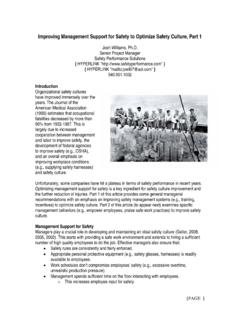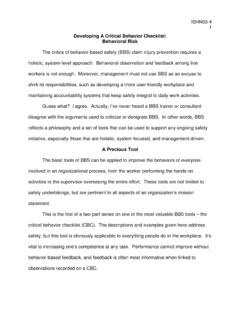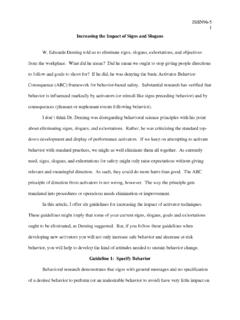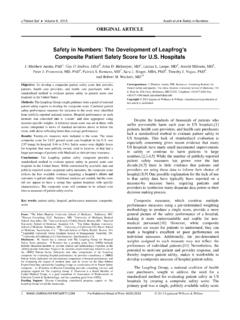Transcription of Creating a Culture Where Employees Own Safety
1 Creating a Culture Where Employees Own Safety Anne R. French, Senior Partner Safety Performance Solutions, Inc. E. Scott Geller, Senior Partner Safety Performance Solutions, Inc. Blacksburg, Virginia Introduction Safety is not something management does to or for Employees . Management commitment to Safety is necessary, but true Safety excellence requires engagement from personnel throughout the organization, especially the hourly Employees . Such engagement in Safety benefits the Employees as well as the organization. In fact, studies recognize that by focusing organizational effort to cultivate a Culture of involvement and participation, zero injuries is achievable. However, Safety must become a cooperative process Where everyone participates to make the workplace safer.
2 Every worker has something meaningful to contribute, and people will contribute if the climate is right. Leadership Support The day-to-day activities and behaviors of organizational leaders form the foundation of an organization's Safety Culture . Managers at all levels of the organization need to exemplify a shared vision of Safety excellence and demonstrate the leadership styles and practices needed to drive the desired Culture change, including fostering a sense of employee ownership of Safety . The importance of management support and leadership to the overall Safety Culture cannot be over emphasized. Leaders must believe employee Safety is a corporate value, one that should never be compromised. They must consistently demonstrate this value through their own practices, as well as through their formal decisions.
3 When Employees believe Safety is indeed a shared organizational value, they contribute extra effort to Safety improvement initiatives, and they are less likely to succumb to the natural and imposed pressure to circumvent safe work practices. To increase the visibility of management support among the hourly Employees , organizations should continue to emphasize their traditional initiatives, taking special care to ensure the efforts are communicated and understood by the Employees . These may include providing quick follow-up and/or feedback to environmental hazards identified, redesigning ineffective Safety training courses, and giving Employees opportunities to express their Safety concerns. Of course, any time employee input is sought, it is essential to have a process in place for providing prompt feedback and follow-up.
4 1. Leaders need to help Employees feel they are doing worthwhile work and are therefore important. Too often, negative feedback can belittle one's sense of importance, and that's disastrous for voluntary participation. That's why it's critical to emphasize a person's positive contributions to the work place. When people believe their work is genuinely appreciated, they want to improve and do their best. They become self-motivated. There's probably no faster way to decrease employee involvement than to apply negative consequences in an attempt to correct behaviors such as giving an individual an embarrassing reprimand for working at-risk or for not following a designated Safety procedure. Punishment is detrimental to long-term participation and can turn individuals and an entire work Culture against those doing the punishing.
5 Use punishment as a last resort only after you've tried the many other more positive and effective techniques. Managers themselves may inadvertently contradict their true support for Safety through their interpersonal interactions with Employees . For example, it's common for managers to overlook and fail to correct at-risk work practices they observe. While it may be easier to disregard small . infractions, the unspoken message sent is that the at-risk behavior is acceptable, and in fact, short-cuts in general are tolerable, especially when they benefit production. Managers need to consider the variety of ways their own behavior can negatively influence others' perceptions of their support for Safety and avoid these all-too-common mistakes.
6 Because hourly Employees are often far removed from the day-to-day decisions being made by management, their awareness of management's consideration of Safety issues may be limited. Without effective communications systems in place, many management decisions and actions supporting Safety are never known or realized by Employees . Conversely, the rationale for decisions which may not appear to take Safety into account is not understood. An extra effort should be made to publicize Safety -related initiatives throughout the workforce. The Employees need to be made aware of the improvement efforts being championed, and the rationale behind decisions made, in order for them to fully realize management's commitment to improving Safety .
7 When Safety is not held as a value in the organization, proactive Safety initiatives among hourly workers are rare. In these organizations, Safety is not considered in the broader organizational decisions. Safety only gets addressed when there is an incident, such as an OSHA recordable, a union grievance, or a public revelation. Because the values of an organization drive the decisions leaders make to direct the actions of a company, employee involvement or engagement in Safety requires that Safety is among the corporate values. When Safety is a corporate value, leaders integrate Safety into all strategic and tactical decisions. Every decision can have an impact on Safety . Thus Safety should be considered in every corporate decision that impacts Employees .
8 We also have to consider that some leaders simply do not know how to make Safety a value. They may not have experienced this perspective in their careers or professional background. The major hurdle to making Safety a corporate value is the additional time it will take to build and manage strong Safety systems and integrate these in all other management processes. System-Based To encourage employee engagement in Safety , the Safety infrastructure must invite Employees to become actively engaged. Safety systems and processes must be structured with opportunities for employee involvement and designed to facilitate a sense of ownership and personal control. 2. A Total Safety Culture can only be achieved with a systems approach, including balanced attention to all aspects of the corporate Culture (Exhibit 1).
9 Three basic domains, for example, need attention when designing and evaluating Safety processes and when analyzing contributing factors of close calls and injuries: 1. Environment factors (such as equipment, tools, machines, housekeeping, engineering, management systems);. 2. Person factors ( Employees ' knowledge, skills, abilities, intelligence, motives, personality);. 3. Behavior factors ( Employees complying, recognizing, communicating, actively caring). Two of these categories involve human factors. Each of these generally receives less attention than the environment, largely because it is more difficult to obtain visible consequences of efforts to change the human factors. For example, changes in an environmental factor affect behaviors and attitudes.
10 And behavior change usually results in some change in the environment. When people choose to change their behavior, they adjust their attitudes and beliefs to be consistent with their actions. This change in attitude can influence more behavior change and then more attitude change a spiraling, reciprocal interdependency between our outward actions and our inward feelings. This is how small changes in behavior and attitude can eventually lead to personal commitment and total involvement. Some human factors programs focus on behavior-based Safety management, whereas others focus on attitudes (as in a person-based approach). A Total Safety Culture requires integrating both behavior-based and person-based approaches to understand and influence the human element of a corporate Culture .














